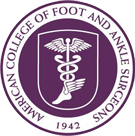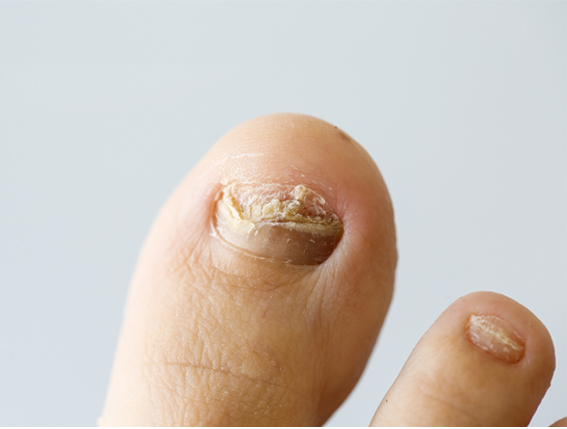Onychomycosis, commonly known as toenail fungus, is a fungal infection that causes the nail to thicken and turn yellow. The toenail fungus starts as slight discoloration and thickening of the nail. However, when left to linger, the fungal infection on your toenail can cause severe damage and pain when walking. Also, this condition is likely to spread to other parts of your foot and cause a foul odor.
Fortunately, when the condition is detected early, treatment using laser technology will eliminate the infection and help you avoid the complications associated with advanced toenail fungus. Dr Kleis will help you diagnose and treat toenail fungus using the most effective cutting-edge laser treatment. We serve clients needing checkups and treatment for toenail fungus in Costa Mesa, CA.
What is Toenail Fungus?
Toenail fungus is a common foot infection that begins as mild discoloration of the affected nail. As the condition worsens, the yellow, white and dark spots become more distinct, causing your nail to become thick and uncomfortable.
Fungus thrives in damp places. Therefore, hot tubs, pools, showers, and saunas are places where you could pick up the nail fungus, especially when these facilities are shared. It may be difficult to know that you have toenail fungus because it begins with small yellow spots under the toenails. However, some factors increase your risk of developing this condition, including:
- Having a history of Athlete’s foot.
- Walking barefoot in damp communal areas.
- Having a lowered immunity, circulation problems, and conditions such as diabetes.
- Being older is associated with a reduced blood flow and many years of exposure to fungus.
- Having mild nail or skin injury where the fungus enters the body.
Toenail fungus may result in severe damage to your toenails and other parts of the foot when left to linger for some time. Some of the symptoms of this condition that you need to look out for include:
- Discoloration of your toenails. One of the obvious signs that you may be developing toenail fungus is the discoloration of the toenails. It would be wise to seek medical care when you notice that your nails have an off-white or yellow tint. The color change may indicate that the infection is working beneath the nails. The discoloration will mostly start on the tip and spread to other areas as the condition worsens.
- Unusual Toenail thickness. As the onychomycosis works its way under your nails, you may notice unusual thickness. Although thick toenails may not seem like a big issue initially, they may cause serious discomfort when left untreated.
- Brittle and cracked nails. When the fungus develops underneath your toes, it deprives your nail of the necessary nutrients that keep it soft. This will cause your toenail to be extremely dry and crack under the slightest pressure.
- Disfigured nails. When the toenail fungus develops, you will experience unusual thickness, disfiguring the toenails. Deformed toenails become difficult to trim and clean. This will cause the condition to worsen and cause more damage.
- Foul odors. When the infection spreads, the affected toenails are likely to give off a foul odor. This may result from the numerous bacteria accumulating under the toenails and spreading to the skin.
- Dark Debris. As the fungal infection worsens, the toenails will begin to fall apart and worse. This causes more debris to accumulate under the nails. Without treatment, the debris encourages the growth and spread of the fungus.
- Nail detachment. Worsening of the toenail fungus can destroy your nail bed. The nail bed is responsible for attaching the nail to your toe, and its destruction will result in detachment. However, nail detachment does not occur instantly. When you receive laser treatment for mild symptoms, you will not have to deal with this issue.
Severe cases of nail fungus could be characterized by permanent damage and pain to the affected area. In addition, this could cause severe infections beyond the toenails to other foot parts.
How Does Onychomycosis Laser Treatment Work
The laser used for toenail fungus removal works to attack the organisms under the nails without damaging the skin and tissues. Unlike other forms of treatment, the light from the laser can penetrate through the nail surface to reach the fungus. Before the treatment procedure, the technicians may file your nails and prepare the area. If you have decals or polish on your nails, you must remove them before reporting for your appointment.
Laser treatment or onychomycosis is often painless. However, you may experience some tingling and warmth on the nail bed as the therapy continues. This is because the laser foot treatment removes the fungus and helps avoid spreading the infection from the toenails to other parts of the foot. After the treatment, you may notice that the pain and discomfort have subsided.
Most patients will only need a single treatment. However, your nail could take from six months to one year to return to its original and healthy state. However, the severity of the infection may affect the healing time. Also, individuals with lower immunity and conditions such as diabetes have a higher risk of developing complications when left with untreated toenail fungus. Therefore, seeking immediate medical attention is crucial when you notice the symptoms of this condition.
Since toenail fungus could worsen and spread to other parts over time, early treatment will help avoid complications such as losing the toenails. Although it is unlikely that toenail fungus will recur after laser treatment, you may need to undergo additional treatment if this happens.
The food and drug association has cleared several laser devices to treat onychomycosis. Some of the common types of laser that your doctor could use to treat this condition include Genesis Plus, Noveon, Pinpoint, and Foot laser. After laser treatment, many people show signs of improvement, and the cure rate is high. In addition, since laser treatment is associated with increased rates of a negative culture, the evidence of infection is not visible in the microscopic test.
Advantages of Laser Treatment for Onychomycosis
Using the laser to treat toenail fungus effectively clears out the odor and unpleasant appearance associated with toenail onychomycosis. In addition, laser treatment will destroy the fungus and stop it from spreading. As soon as your nail grows out, it will return to its original state. Some of the benefits associated with laser treatment for toenail fungus treatment include:
-
Minimal to no pain. Unlike other treatment options like surgery, laser treatment for toenail fungus is virtually painless. Although some patients could experience the warmth and tingling sensations in the affected areas, the treatment procedure should not be painful.
-
Shorter recovery time. There is no downtime or recovery time after laser treatment for toenail fungus. Sometimes you need a single procedure, and you can return to your daily activities after leaving the doctor’s office.
-
Minimal or no side effects. Toenail onychomycosis can be treated using several other treatment options like oral medications and topical creams. Using oral medication or creams could result in allergies and other severe side effects like liver failure. However, you will experience minimal or no side effects with laser therapy.
-
High efficacy rate. In a study done by the FDA in 2016, individuals who used laser treatment for toenail fungus treatment displayed clear nails within three to six months of undergoing treatment.
-
No need for anesthesia. Laser treatment is a safe and effective way to eliminate toenail fungus without the need to use drugs or anesthesia.
-
Suitable for all ages. Unlike medications and creams that could have an age limit for application, laser treatment can be used across all age groups.
Signs that Onychomycosis is Healed After Laser Treatment
Although some people will notice a resolution of the infection after the first appointment, additional sessions could be necessary when the condition is advanced. Some of the signs of improvement for toenails affected by fungus could include:
- Disappearance of the white, brown or yellow discoloration of the nails associated with fungus growth.
- Recovery and proper development of the detached nails.
- Resolutions the debris under the toenails.
- Return your nails to the normal shape and texture.
Comparison between Laser Treatment and Other Treatment Options for Onychomycosis
Several forms of treatment have been historically used to treat toenail fungus. However, laser treatment is the most effective for moderate, mild, and even severe onychomycosis. People have used the following forms of treatment for this condition:
-
Home remedies. Some home remedies like tea tree oil, vinegar, and antifungal products have been used to relieve the symptoms of toenail fungus. Although these home remedies do not have side effects, their success rate in removing the fungus is inconsistent.
-
Topical creams. Sometimes doctors may recommend antifungal crème to be applied on the affected toenails. Antifungal cream may only be effective when used on thin nails. They cannot effectively go below the toenail to the affected area.
-
Oral medications. Compared to the cream, oral medications may be more effective in clearing toenail fungus. However, these medications are likely to come along with side effects like skin rashes or liver damage. Also, it is crucial to note that the condition could reappear after you are done taking medication.
-
Surgery. Sometimes, the doctor can recommend removing your nail to ease applying the antifungal cream. However, this type of treatment could result in a lengthy recovery time and is very invasive.
Laser treatment is painless, and non-invasive is the most successful treatment. The only downside of laser treatment is that you will need to spend more than other treatment options. The expense could be a factor when choosing laser treatment since many health insurance plans do not cover the entire cost of treating this condition. However, it is important to understand that the benefits of laser treatment surpass the cost you incur.
Frequently Asked Questions on Laser Treatment for Toenail Fungus
Toenail fungus can be detected and effectively treated using laser therapy. Therefore, you should not ignore any symptoms of the condition that you experience. The following are some frequently asked questions about laser treatment for onychomycosis:
-
How long does the laser treatment take?
The time needed for laser treatment of this condition varies depending on the severity. When the fungal infection is advanced, your nails could be extremely thick. This means that your toenails must be mechanically reduced to the normal size before the procedure.
-
Can I use nail polish after laser treatment?
Although you must remove any polish from your nails before laser treatment, you can put it back on immediately after the procedure. When you visit a nail salon, you need to ensure that you frequent a place where they properly sanitize the equipment to avoid recurrence of the fungus.
-
Can the toenails fail to improve after treatment?
Laser treatment has been approved by the FDA and shown to be effective. Mild toenail fungus is expected to resolve with a single treatment. Unfortunately, it is impossible to guarantee 100% effectiveness as with all other medical procedures. However, if you take proper care of your feet by avoiding damp areas and wearing breathable shoes, you can prevent a recurrence.
-
Will my health insurance cover laser treatment?
No. Unfortunately, laser treatment for onychomycosis is considered a cosmetic procedure, and most health insurance companies do not cover the treatment. However, it does not hurt to call your insurance provider to seek more details on the situation.
Find a Laser Treatment Expert Near Me
Many people are not self-conscious with their feet. As a result, these people may fail to seek immediate medical care when they notice something wrong. Toenail fungus is one of the many complications that may affect your feet, and a failure to seek immediate care could make things worse. In addition, toenail fungus, commonly known as onychomycosis, can irritate, and many people find it embarrassing.
If you experience any of the symptoms associated with toenail fungus, it is crucial to seek immediate medical care. Toenail fungus is easy to diagnose and treat with modern technology such as laser treatment. However, your health is a sensitive part of your life, and you want to put it in the hands of an experienced and trustworthy doctor.
If you suffer from onychomycosis, it would be wise to have your toenails checked and treated for toenail fungus. Dr. Kleis uses a safe and effective laser to ensure painless and effective laser treatment for your condition. Contact us today at 714-760-4944 if you need laser treatment for your toenail fungus in Costa Mesa, CA.


























